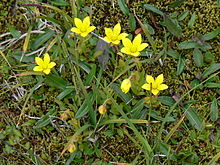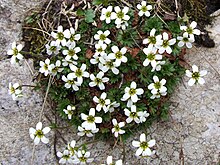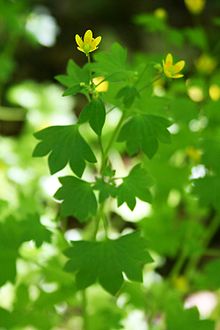Saxifrage
| Saxifrage | ||||||||||||
|---|---|---|---|---|---|---|---|---|---|---|---|---|

Saxifraga sect. Porphyrion : Saxifraga sempervivum |
||||||||||||
| Systematics | ||||||||||||
|
||||||||||||
| Scientific name | ||||||||||||
| Saxifraga | ||||||||||||
| L. |
Saxifrage ( Saxifraga ) is a plant genus in the family Saxifragaceae (Saxifragaceae). The genus includes around 450 to 480 species, some of which are very difficult to distinguish.
Names
The botanical genus name Saxifraga is derived from herba saxifraga and saxifragus ("stones breaking") from saxum for stone and frangere for break.
The common German name Steinbrech (from Middle High German feminine "steinbrëche", related to Saxifraga granulata ) is literally translated from Latin. The name of the genus goes back to Pliny the Elder (quia saxa frangit = because it breaks the rocks). From the place of growth in crevices in the rock it was wrongly concluded that the plant had broken off the rock.
Another interpretation of the name is the fact that, according to the doctrine of signatures, the plants were used as a remedy for kidney and urinary stones . Other, similar interpretation of the name: Saxifrage originally refers to the nodular saxifrage ( Saxifraga granulata ), whose herbs and flowers as well as the small, hard brood onions (also based on the medieval doctrine of signatures) were used as a remedy for bladder stones.
The following saying comes from the 15th century: "If you take the herb's root in wine, it pronounces the stain in the platern (= urinary bladder )".
As saxifraga or saxifrage , however, were formerly also other "stone-breaking" plants such as lesser saxifrage and (especially as "purple saxifrage") Small meadowsweet and some Asplenium referred.
description
Vegetative characteristics
Saxifrage species are rarely one to two-year-old, mostly herbaceous plants . Often they are leaf succulents , many grow as cushion plants, many species form evergreen, basal leaf rosettes and many species are deciduous with leaves that are distributed on the stem . The mostly alternate, stalked or sessile leaves are simple. Leaf margin is lobed or toothed. Stipules are missing.
Generative characteristics
Mostly in panicle , racemose or zymous inflorescences a few to many flowers stand together. The mostly hermaphrodite, mostly radial symmetry , very rarely zygomorphic flowers are usually five-fold. There are usually five (rarely four, seven or eight) sepals present; at most they have grown together at their base. The mostly five (rarely four) free petals are white, yellow to orange or red to purple. There are two circles with five (rarely four) free stamens each. The two lower to mostly upper carpels are only partially fused, with free ends pointing apart.
There are fruit capsules formed containing many seeds.
ecology
The pollination is usually by insects .
Site conditions
Saxifrage species are typical rock plants and debris colonists. In the alpine heights , they are also often found on raw and initial soils (including rendzines ).
Some species can thrive even at extreme altitudes. Sun holds Gegenblättrige saxifrage ( Saxifraga oppositifolia ) the current altitude record in the Alps with 4507 meters at the Dom in Valais .
Systematics and distribution
The genus Saxifraga was established by Carl von Linné in 1753 .
Saxifrage species mainly thrive in temperate and cold climates. There are around 40 species in the Alps .

Saxifraga sect. Ciliatae : Moor saxifrage ( Saxifraga hirculus )

Saxifraga sect. Irregulares : Judenbart ( Saxifraga stolonifera )

Saxifraga sect. Porphyrion : Fettenhennen saxifrage ( Saxifraga aizoides )

Saxifraga sect. Porphyrion : two-flowered saxifrage ( Saxifraga biflora )

Saxifraga sect. Porphyrion : blue-green saxifrage ( Saxifraga caesia )

Saxifraga sect. Porphyrion : Saxifraga federici-augusti subsp. grisebachii

Saxifraga sect. Porphyrion : Opposite saxifrage ( Saxifraga oppositifolia )

Saxifraga sect. Porphyrion : trimmed saxifrage ( Saxifraga retusa )

Saxifraga sect. Ligulatae : Ostrich Saxifrage ( Saxifraga cotyledon )

Saxifraga sect. Trachyphyllum : Moss saxifrage ( Saxifraga bryoides )

Saxifraga sect. Gymnopera : shadow saxifrage ( Saxifraga umbrosa )

Saxifraga sect. Cotylea : Saxifraga taygetea

Saxifraga sect. Mesogyne : Nodding Saxifrage ( Saxifraga cernua )

Saxifraga sect. Saxifraga : Mannsschild saxifrage ( Saxifraga androsacea )

Saxifraga sect. Saxifraga : Leafless Saxifrage ( Saxifraga aphylla )

Saxifraga sect. Saxifraga : Cobweb saxifrage ( Saxifraga arachnoidea )

Saxifraga sect. Saxifraga : Saxifraga facchinii

Saxifraga sect. Saxifraga : Saxifraga granulata ( Saxifraga granulata )

Saxifraga sect. Saxifraga : grass saxifrage ( Saxifraga rosacea )

Saxifraga sect. Saxifraga : three-fingered saxifrage ( Saxifraga tridactylites )

Saxifraga sect. Saxifraga : Dreigabliger saxifrage ( Saxifraga trifurcata )

Saxifraga sect. Saxifraga : Saxifraga wahlenbergii

Saxifraga sect. Merkianae : Saxifraga tolmiei

Saxifraga sect. Micranthes : Star saxifrage ( Saxifraga stellaris )
Two further sections have recently been separated by some authors as a separate genus Micranthes Haworth on the basis of molecular genetic studies :
|
Numerous hybrids are also used as ornamental plants (selection):
- Saxifraga × andrewsii Harvey (probably Saxifraga paniculata × Saxifraga spathularis )
- Saxifraga × apiculata Engler ( Saxifraga marginata var. Rocheliana × Saxifraga sancta )
- Saxifraga × arendsii Engler ( Saxifraga exarata × Saxifraga granulata × Saxifraga hypnoides var. Hypnoides × Saxifraga rosacea )
- Saxifraga × geum L. ( Saxifraga hirsuta × Saxifraga umbrosa )
- Saxifraga × haagii Sünderm. ( Saxifraga ferdinandi-coburgi × Saxifraga sancta )
- Saxifraga × polita (Haworth) Link ( Saxifraga hirsuta × Saxifraga spathularis )
- Porcelain flowers ( Saxifraga × urbium D.A.Webb ( Saxifraga spathularis × Saxifraga umbrosa ))
use
Some saxifrage species and their varieties are also used as ornamental plants for gardens and parks and are used, for example, to border beds, as ground cover , for green roofs and for planting rock gardens and dry stone walls .
In some species, the green parts of the plant are eaten raw or cooked. They are a good source of vitamin C . Some species are also used medicinally.
- Cultivated varieties of Saxifraga arendsii , commercially often called moss saxifrage referred
Saxifraga × arendsii in the Botanical Garden of Zabrze , 2017
Saxifraga Arendsii, Aarhus University Botanical Garden
Saxifraga × arendsii, Einsiedeln , Canton Schwyz , Switzerland
swell
Individual evidence
- ↑ Helmut Genaust: Etymological dictionary of botanical plant names. Birkhäuser, Basel / Stuttgart 1976, ISBN 3-7643-0755-2 , p. 330 f.
- ^ Eberhard Stübler: Leonhart Fuchs and the pharmacognosy. In: Contributions to the Württemberg pharmacy history II (1953–55). No. 2, 1953, pp. 37-40, here: p. 39.
- ^ Jörg Mildenberger: Anton Trutmanns 'Pharmacopoeia'. Part II: Dictionary. I – V, Würzburg 1997 (= Würzburg medical historical research , 56), Volume IV, p. 1863 f.
- ↑ Jerry Stannard: Identification of the plants, described by Albertus Magnus, 'De vegetabilibus', lib. VI. In: Res publica Litterarum 2, 1979, pp. 281-318, here: p. 311.
- ↑ Hans-Joachim Poeckern: The Simplicien in the Nuremberg Dispensatory of Valerius Cordus from 1546 and their explanation in the italic footnotes, with special consideration of the Dioscurides notes and plant descriptions of Valerius Cordus. Mathematical and scientific dissertation, Halle an der Saale 1970, pp. 168 and 176.
- ↑ Jürg Blome: Technical nomenclature investigations into one of the oldest illustrated herbal books in Central Europe. (Short version of the dissertation: transcription, translation and systematic-botanical processing of the herbal book manuscript 'Circa instans' (Mscr. K II 11) from the last quarter of the 14th century, kept in the Basel University Library. Basel 1978) In: “gelêrter der arzeniê, ouch apotêker ”. Contributions to the history of science. Festschrift for the 70th birthday of Willem F. Daems. Edited by Gundolf Keil, Horst Wellm Verlag, Pattensen / Hanover; now at Königshauser and Neumann, Würzburg, 1982 (= Würzburg medical-historical research, 24), ISBN 3-921456-35-5 , pp. 551–588, here: p. 561.
- ^ Christian Körner: Coldest places on earth with angiosperm plant life. doi : 10.1007 / s00035-011-0089-1
- ^ A b The Saxifraga Society
- ↑ Jaakko Jalas, Juha Suominen, Raino Lampinen, Arto Kurtto: Atlas florae europaeae . Volume 12 (Resedaceae to Platanaceae). Helsinki 1999. ISBN 951-9108-12-2 , page 133.
- ↑ Walter Erhardt , Erich Götz, Nils Bödeker, Siegmund Seybold: The great zander. Encyclopedia of Plant Names. Volume 2. Types and varieties. Eugen Ulmer, Stuttgart (Hohenheim) 2008, ISBN 978-3-8001-5406-7 .
- ↑ Entries on Saxifraga at Plants For A Future
literature
- David Allardice Webb , R [ichard] J. Gornall: Saxifrages of Europe, with notes on African, American and some Asiatic species , London 1989.
- Pan Jintang, Richard Gornall, Hideaki Ohda: Saxifraga , page 280 - online with the same text as the printed work , In: Wu Zheng-yi, Peter H. Raven (Ed.): Flora of China. Volume 8: Brassicaceae through Saxifragaceae , Science Press and Missouri Botanical Garden Press, Beijing and St. Louis 2001, ISBN 0-915279-93-2 .
- Jaakko Jalas, Juha Suominen, Raino Lampinen, Arto Kurtto: Atlas florae europaeae. Volume 12, Resedaceae to Platanaceae. Helsinki 1999, ISBN 951-9108-12-2 , pp. 128-216.
- Klaus Kaplan in Gustav Hegi : Illustrated flora of Central Europe. Volume IV, Part 2 A, 3rd edition, pages 130-223. Blackwell Wissenschaftsverlag Berlin 1995, ISBN 3-8263-3016-1 .


















